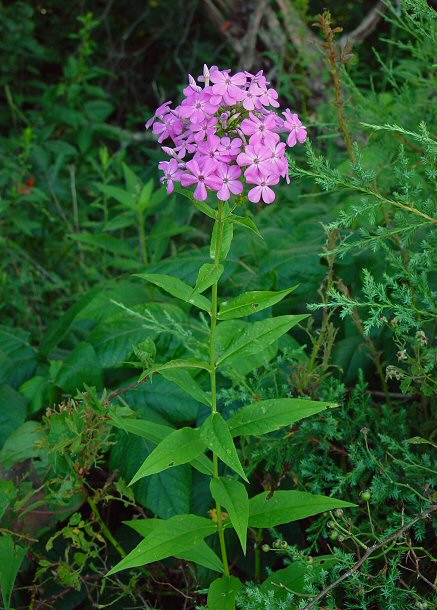Phlox paniculata L.
Perennial Phlox

Native
CC = 3
CW = 3
MOC = 60
© DETenaglia
Phlox paniculata L.Perennial Phlox | |
 |
Native CC = 3 CW = 3 MOC = 60 |
© DETenaglia |
|
Family - Polemoniaceae Habit - Perennial forb with short, thick rhizomes. Stem - Ascending or erect, to 1.2 m, often 3-7 from base, with 20-35 nodes, glabrous toward the base, grading to sparsely to densely pubescent above the midpoint with short, curved, usually nonglandular hairs, sometimes with red streaks.
Leaves - Opposite (the uppermost sometimes subopposite), simple, entire, sessile or nearly so. Blades narrowly elliptic to oblong-lanceolate, angled or more commonly tapered to a sharply pointed tip, variously angled or tapered at the base, the uppermost sometimes ovate, those of the largest leaves 9-14 cm long and 20-40 mm wide, the upper surface usually glabrous, the undersurface glabrous or less commonly sparsely short-hairy, the margins short-hairy, the secondary veins forming closed loops.
Inflorescences - Panicles with usually 35 to more than 200 flowers, the aggregate usually broad, domed to hemispheric or pyramidal, occasionally narrower and appearing somewhat racemelike.
Flowers - Flower stalks 2-8 mm. Calyces 6-10 mm long, the lobes slender, tapered evenly to sharply pointed tips, glabrous or pubescent with short, nonglandular hairs. Corollas trumpet-shaped, bright pink to light pinkish purple or purple, the tube 18-25 mm long, sparsely to densely hairy externally, the lobes 6-12 mm long and 4-11 mm wide, obovate to broadly obovate, rounded at the tips, occasionally with a very shallow apical notch. Stamens with the filaments 15-21 mm long, the anthers positioned near the stigma and near the mouth of the tube (occasionally 1-3 slightly exserted). Style 12-24 mm long, the stigmas 0.8-1.3 mm long.
Fruits - Capsules with 1-3 seeds.
Flowering - June - September. Habitat - Forests, streambanks, fens, bluff bases, roadsides, shaded disturbed areas. Origin - Native to the U.S. Lookalikes - Other species of Phlox, of which there are several. Other info. - Of the species of Phlox which occur in Missouri, this is the showiest and the one most often cultivated. Within the state it is found mainly south of the Missouri River. Its North American distribution mainly extends from Missouri northward and eastward into New England and also Canada. More northern populations are considered introduced or escapes from cultivation. Photographs taken along Logan Creek, Reynolds County, MO., 7-17-03 (DETenaglia); also at Indian Camp Creek Park, St. Charles County, MO, 10-24-2016, Shaw Nature Reserve, Franklin County, MO, 07-20-2017, and Woodson K. Woods Conservation Area, Crawford County, MO, 9-17-2021 and 8-8-2023 (SRTurner). |